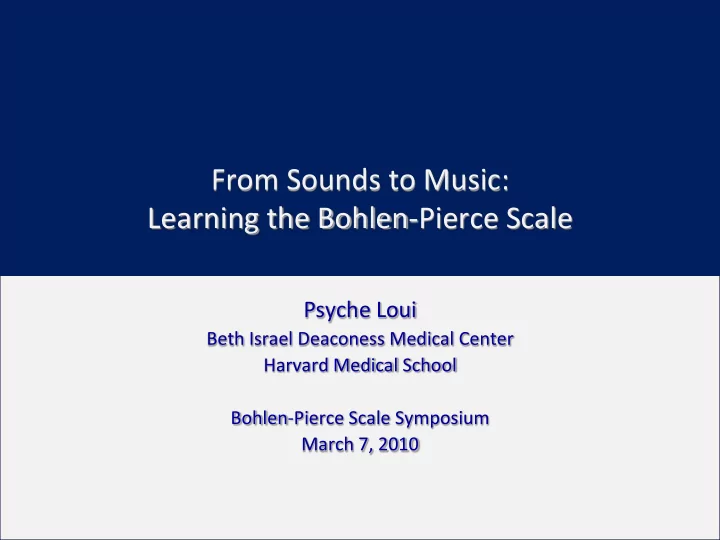

From Sounds to Music: Learning the Bohlen-Pierce Scale Psyche Loui Beth Israel Deaconess Medical Center Harvard Medical School Bohlen-Pierce Scale Symposium March 7, 2010
The world knows and loves music
Whence musical knowledge? Perspectives: Developmental studies Cross-cultural studies Artificial system Bohlen-Pierce scale
The tritave as a musical system Bohlen-Pierce 700 F = 220 * 3 n /13 3 : 5 : 7 600 frequency (Hz) 500 400 300 200 0 1 2 3 4 5 6 7 8 9 10 11 12 13 increments (n)
Composing in the Bohlen-Pierce scale F = 220 * 3 n /13 10 7 10 10 6 4 7 6 0 0 3 0 Krumhansl, 1987 Loui & Wessel, 2008
Composing melody from harmony – applying a finite-state grammar 10 7 10 10 6 4 7 6 0 0 3 0 Loui & Wessel, 2008
Composing melody from harmony – applying a finite-state grammar 10 7 10 10 6 4 7 6 0 0 3 0 Melody: 10 10 4 7 6 10 Loui & Wessel, 2008
Can we learn the B-P scale? General design of behavioral studies: PRE-TEST 1. assess baseline EXPOSURE to melodies in one grammar 2. ~30 minutes POST-TESTS 3. assess learning
Learning a musical system: basic questions Can we recognize old melodies? 2-AFC test of recognition Can we generalize to new melodies? 2-AFC test of generalization Can we learn to like new melodies? Preference ratings
Double dissociation between grammar learning and preference change recognition generalization preference change 100% 1.2 90% 1 (familiar - unfamiliar) Difference in rating Percent Correct 80% 0.8 70% 0.6 60% 0.4 50% 0.2 40% 0 No. of melodies 5 10 15 400 40 27 No. of repetitions 100 1 Loui & Wessel, 2008 Loui, Wessel & Hudson Kam, in press.
Learning a new musical system: more questions Can we learn to expect frequent tones? Probe tone ratings test Probe tone profiles reflect frequencies of compositions Krumhansl, 1990
Testing for expectation for frequencies Probe tone ratings test (Krumhansl, 1990) Melody tone Task: rate how well the tone fits the melody Scale of 1 through 7 Tests conducted both pre- and post- exposure
Pre-exposure probe tone ratings 7 1200 Frequency of exposure 6 1000 5 800 Rating Rating 4 600 Exposure 3 400 2 200 1 0 0 1 2 3 4 5 6 7 8 9 10 11 12 F = 220* 3 n /13 Probe tone Loui, Wessel & Hudson Kam, in press.
Post-exposure probe tone ratings 7 1200 Frequency of exposure 6 1000 5 800 Rating Rating 4 600 Exposure 3 400 2 200 1 0 0 1 2 3 4 5 6 7 8 9 10 11 12 Probe tone Loui, Wessel & Hudson Kam, in press.
Correlating ratings with exposure 1 0.9 0.8 0.7 Correlation (r) 0.6 0.5 0.4 0.3 0.2 0.1 0 Pre Post Exposure Loui, Wessel & Hudson Kam, in press.
Sounds give rise to implicit learning of music Can we observe implicit learning in real time? Music Sounds w ith Event-Related Potentials: Yes
Event-Related Potentials can measure brain activity – Western music Early Anterior Negativity - 5 m V Fza 1000ms 150-200ms + Late Negativity Deviant 500-550ms Standard Loui et al, 2005
Event-Related Potentials can measure brain activity in the Bohlen Pierce scale Experiment design: Chord progressions: Standard 70% Deviant 20% Fadeout 10% Amplitude change detection task Attending to auditory stimuli but not to harmony Dissociating perception from decision-making Loui, Wu, Wessel, & Knight, 2009.
ERP responses to Bohlen-Pierce scale Early Anterior Negativity AFz [µV] Late -2 Negativity 150 – 210ms 0 2 0 500 [ms] Deviant Standard 500 – 550ms ERPs for improbable chords in B-P scale elicit EAN and LN. Loui, Wu, Wessel, & Knight, 2009.
Effects driven by probability? Probability of exposure vs. surface features of stimulus Equal probability AFz [µV] -2 0 2 0 500 [ms] Loui, Wu, Wessel, & Knight, 2009.
Learning probability during exposure Fz [µV] Standard Early -2 EAN peak amplitude 0 -5 2 Standard Late amplitude ( m V) 0 500 [ms] -4 Fz -3 [µV] Early -2 -2 0 -1 Deviant Early 2 0 0 500 [ms] Early Late Fz Late [µV] -2 0 Deviant Late 2 0 500 [ms] Loui, Wu, Wessel, & Knight, 2009.
ERP amplitude reflects individual differences 3 2.5 2 EAN amplitude ( m V) 1.5 1 R = 0.75 0.5 0 0.3 0.4 0.5 0.6 0.7 0.8 0.9 1 -0.5 -1 Generalization (proportion correct) Loui, Wu, Wessel, & Knight, 2009.
Statistics of sounds give rise to musical knowledge - Music + Sounds 7 6 5 4 3 2 1 0 0 1 2 3 4 5 6 7 8 9 10 11 12 Statistics and acoustics constrain music by limiting what we can learn.
Sound spectrum constrains knowledge in music 7 1200 Frequency of exposure 6 1000 5 800 Rating 4 600 3 400 2 200 1 0 0 1 2 3 4 5 6 7 8 9 10 11 12 Probe tone
Sound spectrum constrains knowledge in music
Sound spectrum constrains knowledge in speech and language? Wordle.net
Acknowledgements Center for New Music & Audio David Wessel Technologies Erv Hafter Auditory Perception Lab Carla Hudson Kam Language & Learning Lab Bob Knight Knight Lab UC Berkeley Psychology Marty Woldorff (Duke) Carol Krumhansl Research Assistants (Cornell) Charles Li Elaine Wu Shaochen Wu Pearl Chen Judy Wang Young Lee
Recommend
More recommend